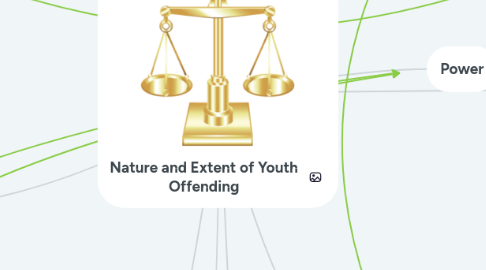
1. bidirectional relationships: a child's family, school peers and neighbourhood.
2. Ecology
2.1. Sensation seeking leads adolescents to seek friends with similar interests. These peers further encourage risk taking behavior
2.1.1. - environmental impacts - relationships
2.2. mesosystems
2.2.1. - school - home - youth centres - work - educational places - child care facilities etc
2.3. Socioeconomic status
2.4. exosystems
2.4.1. 3rd layer of the environmental system. Settings that indirectly influence a child's development.
2.5. macrosystems
2.6. microsystems
2.6.1. Young people aged 15 to 24 years are at a higher risk of assault than any other age group in Australia.
3. Statistics
3.1. age crime curve
3.1.1. maturation
3.1.1.1. chronosystem
3.1.1.1.1. socio-historical context
3.2. 88% of young people in custody reported symptoms consistent with a mild, moderate or severe psychiatric disorder
3.3. juveniles aged 15 years and under are more likely to have compromised ability to act as competent defendants in court
4. Structuration
4.1. structure
4.1.1. connections and networks which influence or limit the choices and opportunities available.
4.1.2. - social class - religion - gender - ethnicity - ability
4.1.2.1. Concepts of class: - power - prestige - property (Karl Marx & Max webber)
4.1.2.2. British Child Migrants and the Indigenous Stolen Generations, placed in care in the 20th century experienced frequent arrests and repeated periods of incarceration throughout their lives.
4.2. agency
4.2.1. the capacity of individuals to perceive their situation, reason about it, consciously monitor their action & form motives etc.
4.2.2. - iteration - projectivity - practical evaluation.
4.2.2.1. Doli incapacitated: The child does not understand the nature of their conduct.
4.2.2.1.1. The age of criminal responsibility needs to factor in disability/trauma etc
5. influences behaviour
6. leads to symbolic violence such as; gender dominance and racism
7. Power
7.1. capital
7.1.1. economic capital
7.1.1.1. monetary resources
7.1.1.2. cash
7.1.1.3. property
7.1.2. social capital
7.1.2.1. trust
7.1.2.2. shared values & norms
7.1.2.3. sense of identity
7.1.2.4. interpersonal relationships
7.1.3. cultural capital
7.1.3.1. - knowledge - education - skills
7.2. symbolic power
8. Offences
8.1. minor
8.1.1. - Vandalism - Theft - Assault
8.2. serious
8.2.1. - Murder - Sexual assault - Rape
8.3. peak age of offence 16-20
8.4. resource-intensive
8.4.1. crime creates employment
9. Media representation of youth
9.1. context of "serious offenders"
9.1.1. moralistic panic
9.1.1.1. informed responses / problematic responses
9.1.1.2. deviant and criminal identities are constructed through processes of labelling
9.1.2. limitation of crime statistics
9.2. peer labelling and stigmatisation
9.2.1. increased risk of victimisation
